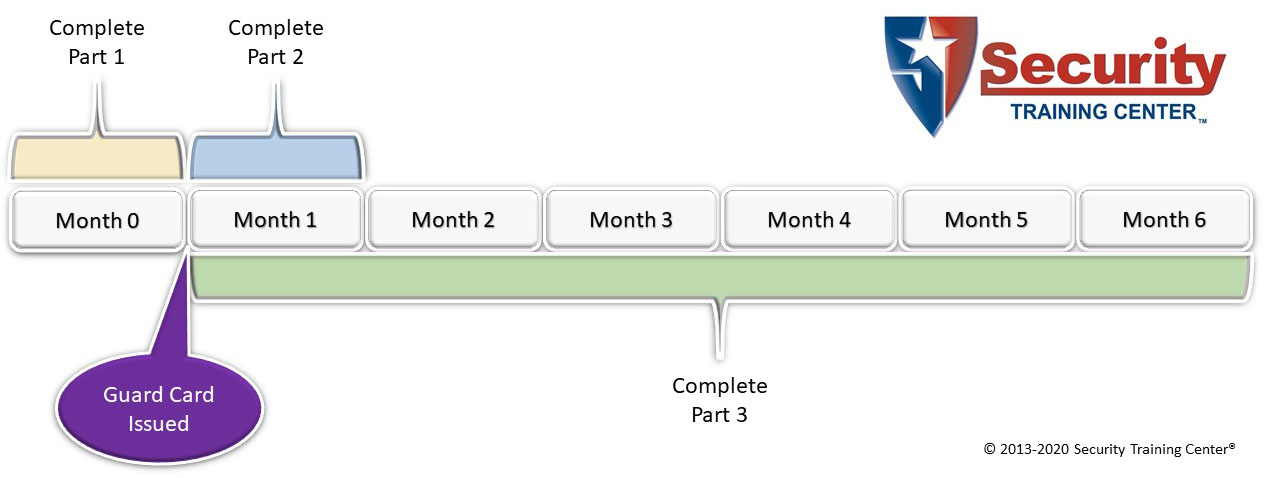
California BSIS Part 3, Mandatory and Elective Courses
16-Hours Pre-assignment Guard Card Training Class
This course supports mobile devices.
Part 3 must be completed after the "Powers to Arrest and WMD" class (Part 1) and Part 2 (16-hours). Combined, Parts 2 and 3 represent the remaining 32-hours of the mandatory 40-hours of training.
Part 2 and Part 3 may be purchased individually or taken as a unit. The course content is identical regardless of the package purchased.
NOTE: The courses must be taken in order.
- The student has 210-days (7-months) to complete the training.
After 210-days, the course expires. No refunds apply.
Guard Training Timelines
You may stand post after an eight-hour course and receiving your Guard Card from the State of California. Afterwards, you have 30-days to complete your first sixteen hours of training and then another six months to complete the remaining sixteen hours (for a total of forty hours of training). You may elect to take all forty-hours of Security Guard Card training at one time.

Online Course Completion
Certificate of Completion:
- Certificate of Completion.
Downloadable from the Transcripts page.
Chemical Agents Certification (included in Part 3 as Lesson 10):
- Chemical Agents ID Response Form.
Must be completed and returned in order for us to print and mail Chemical Agents ID Card. - Printed, hard plastic, Chemical Agents ID Card is mailed (US Postal) after reciept of Chemical Agents ID Response Form.
| Course | Price | Buy | Login |
|---|---|---|---|
| Part 3 | $37.99 |
Video: About the Part 3 Course.
About the STC Online Guard Card Training Part 3 Course.
Part 3
California BSIS Part 3 is a 16-hours program. This section familiarizes and instructs the student in basic skills and provides a common body of knowledge in the performance of security guard work delineated by Business and Professions Code Section 7583.6 (b).
This section must be completed within six (6)-months from the day the guard's registration card is issued or the day the guard begins employment.
Part 3 is comprised of five (5) lessons:
Cost: $37.99
Lesson 7, Communication and its Significance
Objectives:
- Understand the importance of effective internal and external communication
- Understand the importance of reading and understanding Post Orders
- Recognize the need for confidentiality of protocols and contact information
- Know the basic information to collect in an emergency
- Be able to make a direct and efficient call for assistance
- Understand the common types of communication systems
- Be able to effectively use common communication systems
- Complete the Communication and its Significance Final Exam with a 100% score in accordance with regulations.
Subjects
- Internal Protocols
- External Protocols
Lesson 8, Liability/Legal Aspects
Objectives:
- Understand the difference between the court proceedings and the burden of proof for criminal and civil courts
- Understand the penalties for criminal prosecution and civil litigation
- Understand the personal liability of security officer
- Understand the liability of the guard company
- Understand the liability of the client
- Understand the criminal, civil and administrative process
- Know and understand the BSIS Code and Regulations
- Understand the role of the security guard
- Complete the Liability/Legal Aspects Final Exam with a 100% score in accordance with regulations.
Subjects
- Introduction to Criminal, Civil and Administrative Courts
- Personal, Security Firm and Site Owner Liability
- BSIS Code and Regulations
- Role of a Security Guard
Lesson 9, Handling Difficult People
Objectives:
- Summarize four specific reasons why consumers may become violent
- Identify personal reactions to confrontation
- Understand personal Risk Factors related to violent behavior
- Explain the Stress Model
- Discuss the Theoretical Models of Assault
- Understand how the working environment can affect behavior.
- Configure a safe working environment
- Complete the Handling Difficult People Final Exam with a 100% score in accordance with regulations.
Subjects
- Communications and Conflict Management
- Recognizing and Responding to Pre-Attack Indicators
- The Tueller Principle
- Handling Difficult Personalities
Lesson 10, Chemical Agents
Objectives:
- Understand a brief history of tear gas
- Understand the chemical properties of hand-held defensive sprays
- Understand the different types of hand-held defensive spray canisters and nozzles
- Understand the criminal and civil implications of deploying chemical agents
- Understand defensive spray decontamination procedures
- Understand the principles of proper deployment of hand-held defensive sprays
- Understand the limitations of hand-held defensive sprays
- Understand the proper maintenance, storage and disposal of hand-held defensive sprays
- Complete the Chemical Agents Final Exam with a 100% score in accordance with regulations.
Subjects
- Tear Gas Use and Effects
- Pepper Spray Use and Effects
- Deploying Chemical Agents
Lesson 11, Preserving the Incident Scene
Objectives:
- Be able to identify common forms of evidence
- Explain proper care and handling of evidence
- Summarize the correct procedure to secure a scene
- Understand common legal issues regarding evidence
- Collect appropriate information from witnesses
- Identify types of evidence
- Complete the Preserving the Incident Scene Final Exam with a 100% score in accordance with regulations.
Subjects
- Identifying Evidence and Witnesses
- Care and Handling of Evidence
- Legal Issues to Evidence Tampering and/or Removal
- Securing the Immediate Area
